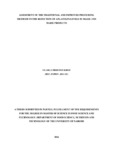| dc.contributor.author | Kirui, Clara, C | |
| dc.date.accessioned | 2017-01-03T09:42:32Z | |
| dc.date.available | 2017-01-03T09:42:32Z | |
| dc.date.issued | 2016 | |
| dc.identifier.uri | http://hdl.handle.net/11295/98608 | |
| dc.description.abstract | Aflatoxins are fungal secondary metabolites produced predominantly by certain strains of the Aspergillus molds that if ingested in acute or chronic toxicity and a variety of other adverse effects on both humans and animals. The objective of this study was to investigate the effectiveness of traditional processing methods which included decortication by pounding of wet maize with mortar and pestle, alkaline cooking using Magadi soda and maize cob ash and improved methods which included dehulling in mechanical mill, exposure to solar and artificially generated UV radiation in reduction of aflatoxin in maize. Standardization of alkali cooking was done before the actual treatment of the contaminated samples. Naturally contaminated samples of maize from the National Cereals and Produce Board’s stores were sampled according to the standard sampling procedure for cereals and pulses to make a composite sample. Aflatoxin analysis before and after each of the treatments was done to check for their effect on reduction of aflatoxin using ELISA (Boratest® Technology) and expressed as total aflatoxins in ppb, dry weight basis. The results were subjected to statistical analysis at the significance levels 5% (p≤0.05). The success of any method was based on their ability to lower the levels to below the maximum allowable limits as set by the Kenya Bureau of Standards and East Africa Standard, which is 10ppb for total aflatoxin.
The reduction of aflatoxin was found to be highest when maize was boiled in maize cob ash solution and it resulted in loss of aflatoxin from 83.1±0.3 ppb to 7.0±3.9 ppb. Dry decortication reduced aflatoxin from 51.3±15.3 to 9.6±0.8ppb, boiling in Magadi soda led to a drop of aflatoxin from 59.5±3.818ppb to 13.4±0.424ppb, solar irradiation for 18 hours caused a drop of aflatoxin from 60.8±1.8ppb to 13.7±0.1 ppb, UV irradiation for 18 hours caused a reduction from 81.7±0.5ppb to 61.4±4.5 and pounding in Magadi soda resulted in least loss of aflatoxin from 81.5±0.3 to 72.7±0.2ppb. Aflatoxin loss in all the treatments was significant except for dry decortication. Only dry decortication and boiling in maize cob ash solution brought down the aflatoxin levels to below the maximum allowable limit of 10ppb. | en_US |
| dc.language.iso | en | en_US |
| dc.publisher | University of Nairobi | en_US |
| dc.rights | Attribution-NonCommercial-NoDerivs 3.0 United States | * |
| dc.rights.uri | http://creativecommons.org/licenses/by-nc-nd/3.0/us/ | * |
| dc.subject | Assessment of the Traditional and Improved Processing Methods | en_US |
| dc.title | Assessment of the Traditional and Improved Processing Methods in the Reduction of Aflatoxin Levels in Maize and Maize Products | en_US |
| dc.type | Thesis | en_US |
| dc.description.department | a
Department of Psychiatry, University of Nairobi, ; bDepartment of Mental Health, School of Medicine,
Moi University, Eldoret, Kenya | |



